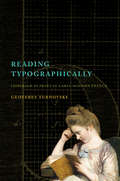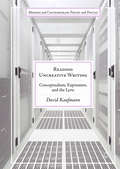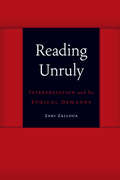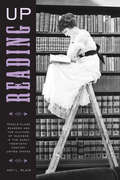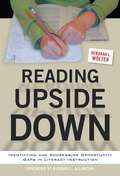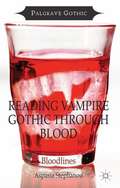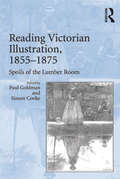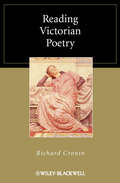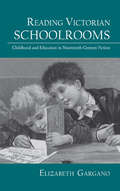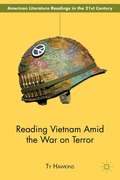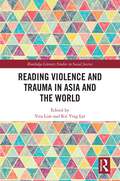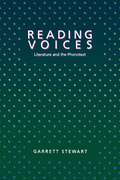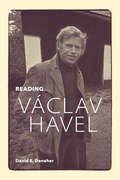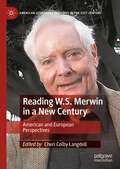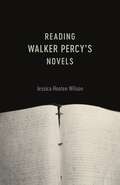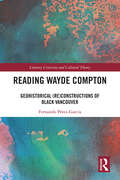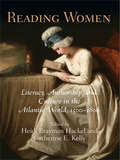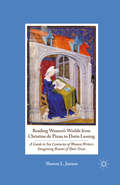- Table View
- List View
Reading Typographically: Immersed in Print in Early Modern France (Stanford Text Technologies)
by Geoffrey TurnovskyAnxieties about the fate of reading in the digital age reveal how deeply our views of the moral and intellectual benefits of reading are tied to print. These views take root in a conception of reading as an immersive activity, exemplified by the experience of "losing oneself in a book." Against the backdrop of digital distraction and fragmentation, such immersion leads readers to become more focused, collected, and empathetic. How did we come to see the printed book as especially suited to deliver this experience? Print-based reading practices have historically included a wide range of modes, not least the disjointed scanning we associate today with electronic text. In the context of religious practice, literacy's benefits were presumed to lie in such random-access retrieval, facilitated by indexical tools like the numbering of Biblical chapters and verses. It was this didactic, hunt-and-peck reading that bound readers to communities. Exploring key evolutions in print in 17th- and 18th-century France, from typeface, print runs, and format to punctuation and the editorial adaptation of manuscript and oral forms in print, this book argues that typographic developments upholding the transparency of the printed medium were decisive for the ascendancy of immersive reading as a dominant paradigm that shaped modern perspectives on reading and literacy.
Reading Uncreative Writing
by David KaufmannThis book examines Uncreative Writing--the catch-all term to describe Neo-Conceptualism, Flarf and related avant-garde movements in contemporary North American poetry--against a decade of controversy. David Kaufman analyzes texts by Kenneth Goldsmith, Vanessa Place, Robert Fitterman, Ara Shirinyan, Craig Dworkin, Dan Farrell and Katie Degentesh to demonstrate that Uncreative Writing is not a revolutionary break from lyric tradition as its proponents claim. Nor is it a racist, reactionary capitulation to neo-liberalism as its detractors argue. Rather, this monograph shows that Uncreative Writing's real innovations and weaknesses become clearest when read in the context of the very lyric that it claims to have left behind.
Reading Under Control: Teaching Reading in the Primary School
by Alison Kelly Judith GrahamNow in an updated third edition, this best-selling textbook introduces primary teachers to the key issues in how to teach reading. The authors celebrate reading as an important, exhilarating part of the curriculum with the potential to transform lives, whilst also giving a balanced handling of contentious issues. Strongly rooted in classroom practice, the book provides comprehensive coverage of differing reading practices and resources. Key features include: managing specialized reading difficulties, such as dyslexia EAL and gender issues in reading use of ICT within reading a detailed inspection of the phonics debate. This book is essential reading for both trainee teachers and qualified teachers interested in continuing their professional development.
Reading Unruly: Interpretation and Its Ethical Demands (Symploke Studies in Contemporary Theory)
by Zahi ZallouaDrawing on literary theory and canonical French literature, Reading Unruly examines unruliness as both an aesthetic category and a mode of reading conceived as ethical response. Zahi Zalloua argues that when faced with an unruly work of art, readers confront an ethical double bind, hesitating then between the two conflicting injunctions of either thematizing (making sense) of the literary work, or attending to its aesthetic alterity or unreadability. Creatively hesitating between incommensurable demands (to interpret but not to translate back into familiar terms), ethical readers are invited to cultivate an appreciation for the unruly, to curb the desire for hermeneutic mastery without simultaneously renouncing meaning or the interpretive endeavor as such. Examining French texts from Montaigne’s sixteenth-century Essays to Diderot’s fictional dialogue Rameau’s Nephew and Baudelaire’s prose poems The Spleen of Paris, to the more recent works of Jean-Paul Sartre’s Nausea, Alain Robbe-Grillet’s Jealousy, and Marguerite Duras’s The Ravishing of Lol Stein, Reading Unruly demonstrates that in such an approach to literature and theory, reading itself becomes a desire for more, an ethical and aesthetic desire to prolong rather than to arrest the act of interpretation.
Reading Up: Middle-Class Readers and the Culture of Success in the Early Twentieth-Century United States
by Amy BlairA person who reads a book for self-improvement rather than aesthetic pleasure is “reading up.” Reading Up is Amy Blair's engaging study of popular literary critics who promoted reading generally and specific books as vehicles for acquiring cultural competence and economic mobility. Combining methodologies from the history of the book and the history of reading, to mass-cultural studies, reader-response criticism, reception studies, and formalist literary analysis, Blair shows how such critics influenced the choices of striving readers and popularized some elite writers. Framed by an analysis of Hamilton Wright Mabie's role promoting the concept of “reading up” during his ten-year stint as the cultivator of literary taste for the highly popular Ladies' Home Journal, Reading Up reveals how readers flocked to literary works that they would be expected to dislike. Blair shows that while readers could be led to certain books by a trusted adviser, they frequently followed their own path in interpreting them in unexpected ways.
Reading Upside Down: Identifying and Addressing Opportunity Gaps In Literacy Instruction
by Deborah L. WolterReading Upside Down offers a paradigm shift from achievement gaps to opportunity gaps in literacy instruction. Drawing on the author's rich experiences working one-on-one with challenged readers, this book presents case studies illustrating the complexities of student learning experiences and the unique circumstances that shaped their acquisition of literacy. Wolter explores eight key factors that contribute to reading challenges in developing readers, including school readiness, the use of prescribed phonics-based programs, physical hurdles, unfamiliarity with English, and special education labeling. With a focus on the differences that educators can make for individual students, the text suggests ways to identify and address early opportunity gaps that can impact students throughout their entire educational career.
Reading Vampire Gothic Through Blood
by Aspasia StephanouReading Vampire Gothic Through Blood examines the manifestations of blood and vampires in various texts and contexts. It seeks to connect, through blood, fictional to real-life vampires to trace similarities, differences and discontinuities. These movements will be seen to parallel changing notions about embodiment and identity in culture.
Reading Victorian Illustration, 1855-1875: Spoils of the Lumber Room
by Paul GoldmanIn a reevaluation of that period in Victorian illustration known as 'The Sixties,' a distinguished group of international scholars consider the impact of illustration on the act of reading; its capacity to reflect, construct, critique and challenge its audience's values; its response to older graphic traditions; and its assimilation of foreign influences. While focused on the years 1855 to 1875, the essays take up issues related to the earlier part of the nineteenth century and look forward to subsequent developments in illustration. The contributors examine significant figures such as Ford Madox Brown, Frederick Sandys, John Everett Millais, George John Pinwell, and Hablot Knight Browne in connection with the illustrated magazine, the mid-Victorian gift book, and changing visual responses to the novels of Dickens. Engaging with a number of theories and critical debates, the collection offers a detailed and provocative analysis of the nature of illustration: its production, consumption, and place within the broader contexts of mid-Victorian culture.
Reading Victorian Poetry (Wiley Blackwell Reading Poetry #9)
by Richard CroninReading Victorian Poetry offers close readings of poems from the Victorian era by a renowned scholar. The selection includes a range of canonical and lesser known writers Skilfully conveys the breadth and diversity of nineteenth-century poetry Offers an ideal balance of canonical and less well-known writers Allows readers to explore the poetry of the Victorian era, through the eyes of one of the most renowned scholars in the field Poets covered include Matthew Arnold, Emily Brontë, Elizabeth Barrett Browning, Robert Browning, Lewis Carroll, A. H. Clough, G. M. Hopkins, Edward Lear, Christina Rossetti, D. G. Rossetti, A. C. Swinburne, Arthur Symons, Alfred Tennyson, Oscar Wilde
Reading Victorian Schoolrooms: Childhood and Education in Nineteenth-Century Fiction (Children's Literature and Culture #44)
by Elizabeth GarganoReading Victorian Schoolrooms examines the numerous schoolroom scenes in nineteenth-century novels during the fraught era of the Victorian education debates. As Gargano argues, the fiction of mainstream and children’s writers such as Dickens, Brontë, and Carroll reflected widespread Victorian anxieties about the rapid institutionalization of education and the shrinking realm of domestic instruction. As schools increasingly mapped out a schema of time schedules, standardized grades or forms, separate disciplines, and hierarchical architectural spaces, childhood development also came to be seen as regularized and standardized according to clear developmental categories. Yet, Dickens, Brontë, and others did not simply critique or satirize the standardization of school experience. Instead, most portrayed the schoolroom as an unstable site, incorporating both institutional and domestic space. Drawing on the bildungsroman’s traditional celebration of an individualized, experiential education, numerous novels of school life strove to present the novel itself as a form of domestic education, in contrast to the rigors of institutional instruction. By positioning the novel as a form of domestic education currently under attack, these novelists sought to affirm its value as a form of protest within an increasingly institutionalized society. The figure of the child as an emblem of beleaguered innocence thus became central to the Victorian fictive project.
Reading Vietnam Amid the War on Terror
by Ty HawkinsArgues that the examination of contemporary American war narratives can lead to newfound understandings of American literature, American history, and American national purpose. To prove such a contention, the book blends literary, rhetorical, and cultural methods of analysis.
Reading Violence and Trauma in Asia and the World (Routledge Literary Studies in Social Justice)
by Yiru Lim Kit Ying LyeThis collection casts the spotlight on Asia and its place in global studies on trauma to explore the ways in which violence and trauma are (re)enacted, (re)presented, (re)imagined, reconciled, and consumed through various mediums in the region. The discussions revolve around the ethics of representing and discussing trauma as we negotiate the tensions between trauma and political, historical, literary, and cultural representations in written, visual, digital, and hybrid forms. It examines how perspectives about trauma are framed, perpetuated, and/or critiqued via theories and research methods, and how a constructive tension between theory, method, and experience is essential for critical discourse on the subject. It will discuss varied ways of understanding violence through multidisciplinary perspectives and comparative literature, explore the "violent psyches" of narratives and writings across different mediums and platforms, and engage with how violence and trauma continue to influence the telling and form of such narratives.
Reading Voices: Literature and the Phonotext
by Garrett Stewart"At last, a scrupulous and sustained--'earsighted'--study of that shadowy yet vital intersection of sound and sense without which literary reading remains a disembodied exercise. . . . Stewart immerses us brilliantly in the poststructural method of a 'phonemic' analysis."--Geoffrey H. Hartman, author of Saving the Text "Stunningly articulate. . . . Alongside brilliant exegeses of passsages from the major English poets, Stewart offers new and dazzling interpretations of the 'poetics of prose' in such novelists as Dickens, Lawrence, Joyce, and Woolf. The book is a tour de force, no doubt about it. In my opinion, Reading Voices will have not only a wide but a lasting reception."--Hayden White, author of Metahistory "This is exciting, virtuoso work in a playfully imaginative hermeneutic mode. Stewart's ear hears fascinating and compelling things, things which have a delightfully rich and thematically complex bearing on much larger textual issues."--Paul Fry, author of The Reach of Criticism "A truly original book. . . . The first work in years to bring together linguistically informed criticism with more philosophically oriented literary theory. The resulting vision of literature is odd, personal, passionate, even outlandish. Not only is Stewart himself and extraordinary stylist, but his work suggests a breakthrough in stylistic criticism so radical as to revitalize the entire field."--Jay Clayton, author of Romantic Vision and the Novel
Reading Václav Havel
by David S. DanaherAs a playwright, a dissident, and a politician, Václav Havel was one of the most important intellectual figures of the late twentieth century. Working in an extraordinary range of genres - poetry, plays, public letters, philosophical essays, and political speeches - he left behind a range of texts so diverse that scholars have had difficulty grappling with his oeuvre as a whole.In Reading Václav Havel, David S. Danaher approaches Havel's remarkable body of work holistically, focusing on the language, images, and ideas which appear and reappear in the many genres in which Havel wrote. Carefully reading the original Czech texts alongside their English versions, he exposes what in Havel's thought has been lost in translation. A passionate argument for Havel's continuing relevance, Reading Václav Havel is the first book to capture the fundamental unity of his vast literary legacy.
Reading W.S. Merwin in a New Century: American and European Perspectives (American Literature Readings in the 21st Century)
by Cheri Colby LangdellThis edited collection explores the work of highly awarded and twice American Poet Laureate W. S. Merwin. Spanning Merwin’s early career, his mid-career success, his Hawaiian epic, his eco-poetry, his lesser-known later poetry and the influence of Buddhism on his work, the volume offers new perspectives on Merwin as a major poet. Exploring his works across the twentieth and twenty-first century, this collection presents Merwin as a necessary and contemporary poet. It emphasizes contemporary readings of Merwin as an environmental advocate, showing how his poetry seeks to help each reader re-establish an intimate relationship with the natural world. It also highlights how Merwin’s work presents our place in history as a pivotal moment of transition into a new era of international cooperation. This volume both celebrates his life and writing and takes scholarship on his work forward into the new century.
Reading Walker Percy's Novels
by Jessica Hooten WilsonWalker Percy (1916–1990) considered novels the strongest tool with which to popularize great ideas among a broad audience, and, more than half a century after they first appeared in print, his works of fiction continue to fascinate contemporary readers. Despite their lasting appeal, however, Percy’s engaging narratives also contain intellectual elements that demand further explication. Philosophical themes, including existentialism, language acquisition theory, and modern Catholic theology, provide a deeper layer of meaning in Percy’s writings.Jessica Hooten Wilson’s Reading Walker Percy’s Novels serves as a companion guide for readers who enjoy Percy’s novels but may be less familiar with the works of Sartre, Camus, Kierkegaard, and Dante. In addition to clarifying Percy’s philosophies, Wilson highlights allusions to other writers within his narratives, addresses historical and political contexts, and provides insight into the creation and reception of The Moviegoer, The Last Gentleman, Love in the Ruins, Lancelot, The Second Coming, and The Thanatos Syndrome. An introduction covers aspects of Percy’s biography that influenced his writing, including his deep southern roots, faith, and search for meaning in life. An appendix offers an explanation of Percy’s satirical parody Lost in the Cosmos: The Last Self-Help Book.Written in an accessible and conversational style, this primer will appeal to everyone who appreciates the nuances of Walker Percy’s fiction.
Reading Wayde Compton: Geohistorical (Re)Constructions of Black Vancouver (Literary Criticism and Cultural Theory)
by Fernando Pérez-GarcíaThis book is a comprehensive analysis of the literary oeuvre of Wayde Compton, examining the interplay between modes of literary production, urban commemoration, the formation of Black racial identity on the margins of the diaspora, and coalitions of solidarity with other communities in Vancouver.Stemming from an interdisciplinary perspective that blends Spatial Literary Studies, Hip hop epistemology, and the transmodern paradigm, this book presents a dynamic model of Black identity formation and belonging, resulting from the remix of Afro-diasporic and transcultural elements and the political commemoration of local Black spaces in an often-understudied node of the Black diaspora. This book also explores Compton’s contribution to recent academic debates on the interaction between the commemoration of Black spaces and the right to the city, as well as the engagement with Indigenous calls for the decolonisation of their ancestral lands. The analysis of Compton’s work allows for the deconstruction of the binaries African/Canadian, Indigenous/settler, Hogan’s Alley/Vancouver and exposes the co-constitutive character of these elements.
Reading William Blake
by Saree MakdisiWilliam Blake (1757‒1827) is one of the most original and influential figures of the Romantic Age, known for his work as an artist, poet and printmaker. Grounding his ideas both in close reading and in the latest scholarship, Saree Makdisi offers an exciting and imaginative approach to reading Blake. By exploring some of the most important themes in Blake's work and connecting them to particular plates from Songs of Innocence and of Experience, Makdisi highlights Blake's creative power and the important interplay between images and words. There is a consistent emphasis on the relationship between the material nature of Blake's illuminated books, including the method he used to produce them, and the interpretive readings of the texts themselves. Makdisi argues that the material and formal openness of Blake's work can be seen as the very basis for learning to read in the spirit of Blake.
Reading Women
by Catherine E. Kelly Heidi Brayman HackelIn 1500, as many as 99 out of 100 English women may have been illiterate, and girls of all social backgrounds were the objects of purposeful efforts to restrict their access to full literacy. Three centuries later, more than half of all English and Anglo-American women could read, and the female reader was emerging as a cultural ideal and a market force. While scholars have written extensively about women's reading in the nineteenth and twentieth centuries and about women's writing in the early modern period, they have not attended sufficiently to the critical transformation that took place as female readers and their reading assumed significant cultural and economic power.Reading Women brings into conversation the latest scholarship by early modernists and early Americanists on the role of gender in the production and consumption of texts during this expansion of female readership. Drawing together historians and literary scholars, the essays share a concern with local specificity and material culture. Removing women from the historically inaccurate frame of exclusively solitary, silent reading, the authors collectively return their subjects to the activities that so often coincided with reading: shopping, sewing, talking, writing, performing, and collecting. With chapters on samplers, storytelling, testimony, and translation, the volume expands notions of reading and literacy, and it insists upon a rich and varied narrative that crosses disciplinary boundaries and national borders.
Reading Women’s Worlds from Christine de Pizan to Doris Lessing
by Sharon L. JansenIn this work, Jansen explores a recurring theme in writing by women: the dream of finding or creating a private and secluded retreat from the world of men. These imagined "women's worlds" may be very small, a single room, for example, but many women writers are much more ambitious, fantasizing about cities, even entire countries, created for and inhabited exclusively by women.

